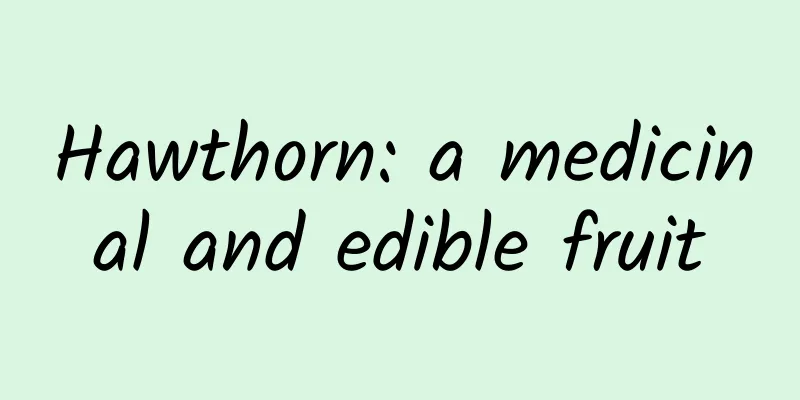Hawthorn: a medicinal and edible fruit

|
"The wind shakes the branches and the flowers look like snow. There are many hawthorns in the lower reaches of the Yellow River. Frost dyes the waxy leaves and the red fruits are ripe. They are everywhere in the mountains and fields inside and outside the Great Wall." This ancient poem vividly describes the beautiful scene of ripe hawthorns in northern China, especially inside and outside the Great Wall. Hawthorn is the fruit of the Rosaceae plant hawthorn and wild hawthorn. Its aliases include tangqizi, mountain pear, sour hawthorn, azalea fruit, rouge fruit, etc. There are nearly 1,000 species of hawthorn plants in the world, 17 of which are native to China and are distributed all over the country. The most recommended are Shanlihong, big fruit hawthorn, Liao hawthorn, Shaanxi hawthorn, etc. The fruit is large, the flesh is thick, and the quality is good. In medicine, the hawthorn produced in the north is called northern hawthorn, and the hawthorn produced in the south is called southern hawthorn. Some people also call the artificially cultivated hawthorn northern hawthorn and the wild hawthorn southern hawthorn. my country has a long history of eating hawthorn. As early as more than 2,000 years ago, Guo Pu's research and annotation of Er Ya said: "The tree is like plum, its fruit is as big as a finger, red like a small nai, and edible. This is hawthorn." This may be the earliest written record. Later, "Tang Materia Medica", "Newly Revised Materia Medica", "Daily Materia Medica", "Shennong Materia Medica Annotations", "Compendium of Materia Medica" and other books all recorded it. "Compendium of Materia Medica" vividly describes: "There are two kinds of it, both of which grow in the mountains. One is small, and the mountain people call it Tangqizi, Maozha, and Houzha, which can be used as medicine... One is large, and the mountain people call it Yangqizi. The tree is more than ten feet tall, and the flowers and leaves are the same, but the fruit is slightly larger and yellow-green in color, with astringent skin and soft flesh. It is very sour and astringent at first, and it can be eaten after frost." Hawthorn contains a variety of nutrients and medicinal substances. According to sampling analysis, every 100 grams of fresh fruit contains 0.7 grams of protein, 0.2 grams of fat, 22.1 grams of sugar, 68 milligrams of calcium, 20 milligrams of phosphorus, 2.1 milligrams of iron, 289 milligrams of potassium and 0.82 milligrams of carotene. It also contains a variety of chemical components such as hawthorn acid, tartaric acid, citric acid, flavonoids, as well as pectin and red pigment. Among them, the calcium content ranks first among many fruits, the vitamin C content is second only to red dates and kiwis, and the carotene content is also higher than many fruits. According to statistics from Beijing University of Traditional Chinese Medicine, among the commonly used Chinese patent medicines, there are 49 kinds made with hawthorn as the main medicinal material, including 46 kinds of pills and powders and 3 kinds of tablets. It is beneficial for digestion and elimination of food stagnation, promoting body fluid and appetizing, promoting blood circulation and removing blood stasis, resisting bacteria and inflammation, astringing and stopping diarrhea, lowering blood lipids and blood pressure, etc. Many people do not like hawthorn when it is eaten fresh because it tastes too sour and slightly bitter. However, it is quite popular when it is processed into flavored snacks and drinks. Hawthorn can also be used in cooking. For example, Shandong "baked red beet" is made with hawthorn as the main ingredient. After removing the core and peeling, it is put into a wok and baked over a low fire. It is rosy and crystal clear, sweet and sour, and tempting to eat. When stewing beef and mutton, put a few hawthorns in the stew, not only will the meat be easy to cook, but it can also remove the odor. However, hawthorn should be consumed in moderation, and those with weak spleen and stomach should use it with caution, especially when eaten raw. Excessive consumption will, as Li Shizhen said, "make people irritable and hungry easily, damage teeth, and is especially not suitable for people with tooth decay." |
<<: Why does eating pumpkin increase blood sugar instead of lowering it?
>>: "Food Safety Guide" Series | Are apple seeds poisonous? Don't chew the seeds of these fruits
Recommend
Do pregnant women need to take cod liver oil?
When babies eat cod liver oil, it helps promote t...
Side effects of moringa seeds on women
Moringa seeds are a kind of food. Currently, mori...
Why does the gloxinia flower not bloom? How can the gloxinia flower bloom?
Gloxinia is a common flower plant in life. Becaus...
A woman's right eyelid twitching, is it auspicious or not?
In many people's cognition, eye twitching see...
Pictures of pregnancy bleeding
In the early stages of pregnancy, there is a poss...
Body weakness during mid-pregnancy
Most women will have varying degrees of pregnancy...
What is the meaning of female testosterone
Many women know that our bodies often secrete and...
White rice has no nutrition? Cold rice has no calories? All the rice issues you care about are here →
Author: Xue Qingxin, registered dietitian Reviewe...
Let you know the past and present of urinary stones
Author: Zhong Xin, deputy chief physician of Shen...
Can’t drink water before a physical examination? This “physical examination notice” is not only useless, but also harmful!
As far as the current situation is concerned, fas...
What can women eat to supplement nutrition
Nowadays, many women are often busy with work or ...
What recipes can pregnant women eat
There are also many nutritional problems during p...
Why is the vagina itchy and the leucorrhea like tofu dregs
Discharge is a normal fluid that flows out of a w...
How long does it take to recover after minimally invasive breast surgery?
The breasts are a woman's second face and are...
Is the period after menstruation a safe period?
Not all newly married couples are in a hurry to h...









